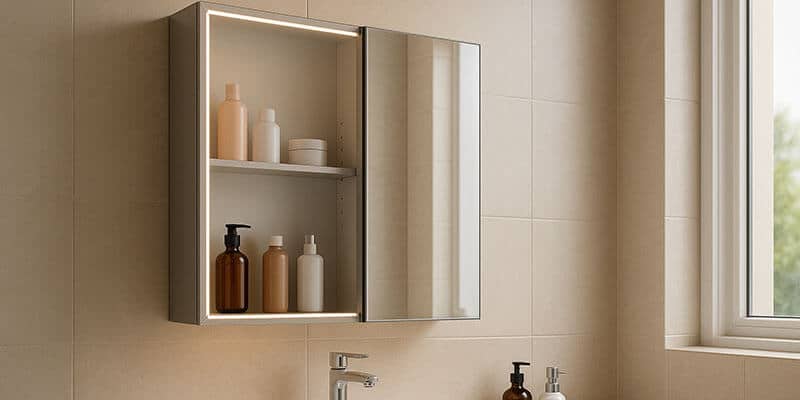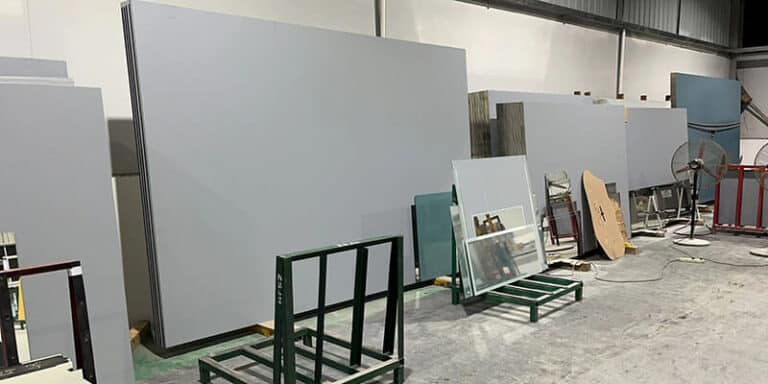Medicine cabinets are gaining popularity as innovative technology develops. More and more homeowners are switching from old-fashioned styles to modern ones with LED lighting, frameless mirror fronts, and other advanced technologies.
Reports say the global medicine cabinet market reached USD 9.6 billion in 2023 and is projected to grow at a CAGR of 5.7% from 2024 to 2032. Smart and LED medicine cabinets have experienced significant growth, with segment share increasing by over 40% between 2020-2024, driven by innovations in voice control, Bluetooth connectivity, and anti-fog technology.
In this guide, we will thoroughly introduce medicine cabinets to help you make the right decision when choosing your next one.
What is a Medicine Cabinet
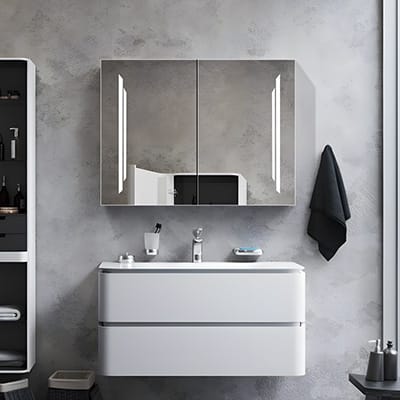
A medicine cabinet is a wall- or recess-mounted bathroom storage unit typically featuring a mirrored or plain front. Its primary purpose is to organize daily medications, first-aid supplies, cosmetics, and toiletries while saving approximately 2 square feet of counter space compared to open shelving.
Installation Types of Medicine Cabinet
Surface-Mount Medicine Cabinets
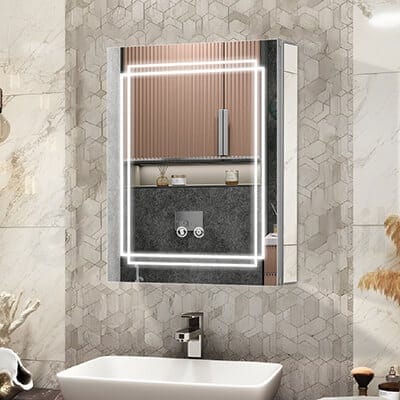
Surface-mount cabinets hang directly on wall studs or tile using brackets or anchors, making them DIY-friendly with installation times under 60 minutes. These relocatable units add 4-8 inches of wall projection, which may be problematic in narrow walkways.
Recessed Medicine Cabinets
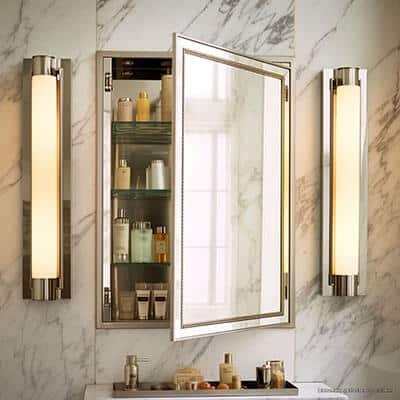
Recessed medicine cabinets fit between wall studs, offering a flush appearance that’s safer in small bathrooms. Installation requires a 14½-inch stud bay width or structural reframing. These cabinets offer a minimalist profile, easier cleaning, and greater resale appeal—a Houzz designer poll found 68% prefer this style.
The main drawback is higher installation costs, ranging from $200-$600 for drywall work, plumbing, and electrical relocation. The Kohler Maxstow recessed cabinet exemplifies this category with its fixed staggered shelves and consistently high ratings.
Corner-Mount Medicine Cabinets

Corner-mount cabinets feature a triangular footprint designed for 90° corners, making them ideal for compact 5 × 8 ft bathrooms. These units are typically surface-mounted with depths of 5-7 inches and widths of 16-20 inches. They provide storage without crowding the mirror over the sink but represent a niche segment with less than 10% of overall sales.
Dual-Mount Medicine Cabinets
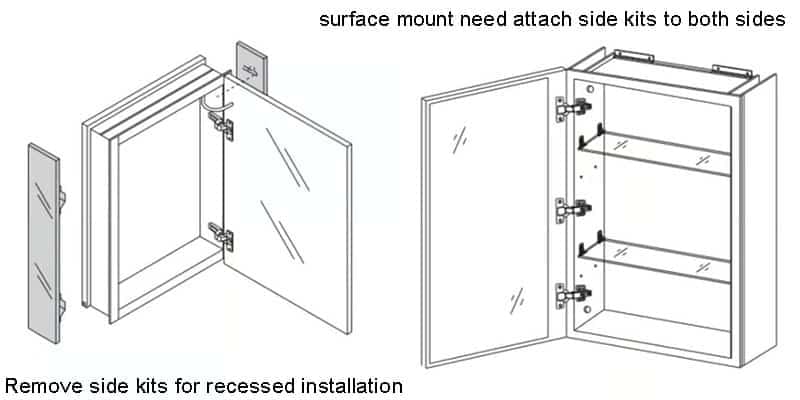
Dual-mount cabinets include convertible housings supplied with both a side-kit and recess box, allowing builders to decide on installation method at later stages. This versatility reduces SKU counts for contractors.
Types of Medicine Cabinet
Medicine Cabinets with Mirrors – Mirror-fronted cabinets are most common, with mirror width typically not exceeding vanity width per OkayMirror’s sizing recommendations. This two-in-one design eliminates the need for a separate mirror while visually expanding the perceived room size.
Medicine Cabinets without Mirrors – These cabinets feature door panels made of wood, metal, or frosted glass, used primarily when an accent mirror is mounted elsewhere. They’re particularly popular in powder rooms.
Frameless Medicine Cabinets – Frameless designs feature edge-to-edge mirror glass bonded to an aluminum box, creating a sleek appearance that’s easy to clean. These units weigh approximately 15% less than framed alternatives and have hidden hinges.
Framed Medicine Cabinets – These cabinets include wood/MDF(Medium-density fibreboard), metal, or composite trim that can be matched to vanity finishes. Many incorporate beveled mirrors for an upscale appearance.
Types of Door
Swing
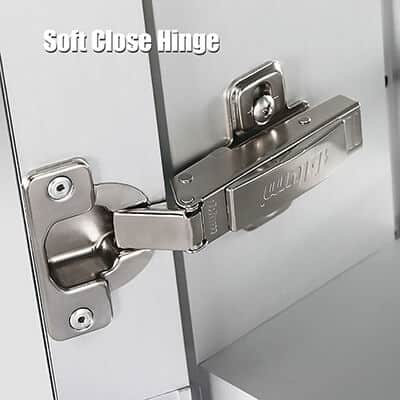
Swing doors are traditional hinged doors that open outward. Hinge options include standard side hinges (right or left). Quality ranges from basic (3,000 cycles) to premium (20,000+ cycles).
Opening angles vary from 90° to 110° on premium models and up to 180° on high-end cabinets.
Features may include soft-close mechanisms, adjustable hinges, and handle-free designs. They require clearance space, making them ideal for bathrooms with adequate room, traditional aesthetics, full access, and budget-friendly options, as they are the most economical door type.
Tri-View Medicine Cabinets
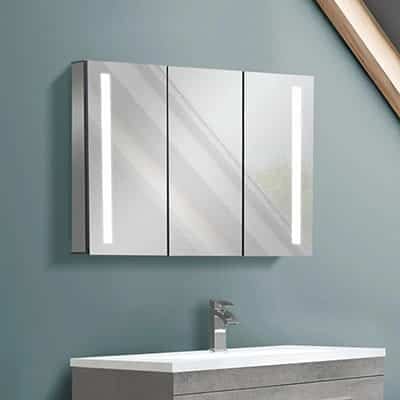
Tri-view medicine cabinets feature three vertical mirror panels that open independently. The center panel typically comprises 40-50% of the total width, with side panels each taking 25-30%. Total widths commonly range from 30-48 inches, with side panels that can open up to 180° for full access.
These cabinets offer compartmentalized storage for multiple users, allow access to one section while others remain closed, and provide approximately 30-40% greater total storage volume than single-door cabinets of the same width. They offer full-width mirrors when closed.
Installation requires precisely level mounting for proper door alignment. Tri-view cabinets are typically surface-mounted due to their width and are heavier than single-door designs (30-50 lbs typically). Common sizes include 30″W × 30″H (small), 36″W × 30″H (medium), and 48″W × 30″H (large).
These cabinets work best in shared bathrooms for couples or families, above double vanities, in master bathrooms with ample wall space, and when creating maximum storage in a single unit. Examples include Glacier Bay 48″ Tri-View, Jensen Hampton Triple Door, and Kohler K-CB-CLW2030TRE.
Slide

Sliding door medicine cabinets feature doors that move horizontally rather than swinging outward. Mechanism options include track-mounted sliding systems, ball-bearing rollers for smooth operation (rated for 15,000+ cycles), soft-close dampeners on premium models, and guide rails to prevent door swaying.
Configuration options include single sliding doors covering half the cabinet, dual sliding doors that move independently, and bypass doors that slide past each other. The main advantages are that no clearance space is needed for door swing (ideal for tight bathroom spaces), doors cannot be left accidentally open, and they offer a modern, sleek appearance.
Limitations include only half the cabinet being accessible at once, tracks requiring occasional cleaning, more complex mechanisms than swing doors, and limited availability (10-15% of market). Sliding door models typically cost 20-30% more than comparable swing-door options.
These cabinets are best suited for narrow bathrooms with limited clearance, above toilets where swing doors would interfere, contemporary bathroom designs, and wheelchair-accessible bathrooms. Examples include Robern M Series sliding door cabinets, Allen + Roth sliding door models, and custom sliding door solutions.
Lift-up
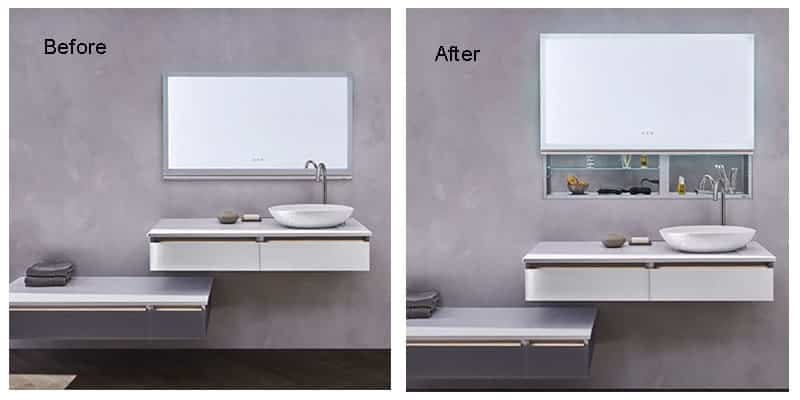
Vertically-opening medicine cabinet. Instead of side hinges, the mirrored door glides straight up on hidden counter-balance mechanisms, parking above eye-level so nothing protrudes into the user’s space.
This type of door opening does not require overhead lighting fixtures that could obstruct the lifting door. Users cannot mount a lighting fixture above the medicine cabinet. However, this is not an issue because current technology allows for integrated lighting, both inside the cabinets and on the front doors, making overhead lighting fixtures unnecessary in most cases.
Medicine Cabinet Materials
Plastic

Plastic medicine cabinets are typically made from ABS (Acrylonitrile Butadiene Styrene) or polypropylene. These lightweight (3-8 lbs) cabinets are molded as single pieces for seamless construction, often textured to mimic more expensive materials, and available in white and limited color options.
The advantages include lowest cost ($30-$100 typical range), natural water resistance, immunity to rust or corrosion, lightweight construction for easy installation, and low maintenance. However, plastic cabinets are less durable than metal or wood options, can look inexpensive or dated, offer limited style variety, may yellow over time with UV exposure, and have shorter lifespans (5-10 years typically).
These cabinets are best for budget renovations, temporary housing, rental properties, children’s bathrooms, and secondary bathrooms. Examples include Zenith Plastic Surface Mount Medicine Cabinet ($35-$60), Project Source basic white plastic cabinets, and IKEA basic plastic models.
Wood
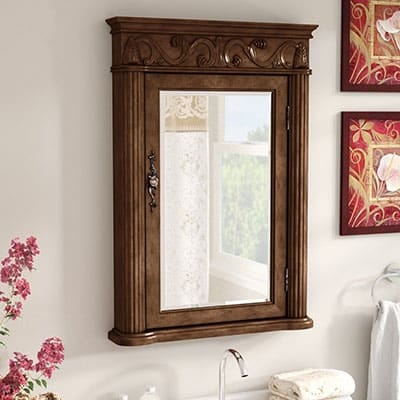
Wood medicine cabinets offer traditional warmth and natural beauty. Common species include oak (durable, pronounced grain, $100-$300), maple (fine grain, takes paint well, $150-$350), cherry (rich reddish tone, ages beautifully, $200-$500), pine (budget-friendly, softer, $75-$200), and MDF with wood veneer (economical option, $80-$250).
Moisture protection includes multiple coats of marine-grade varnish or polyurethane, moisture-resistant MDF cores, engineered wood with melamine coating, and treatments to resist humidity up to 70% RH. Design styles range from traditional raised panel to Shaker, modern minimalist, and rustic/farmhouse with distressed finishes.
Advantages include natural beauty and warmth, ability to be stained or painted to match décor, repairability and refinishability, and solid feel and operation. Considerations include proper sealing to prevent warping, more maintenance than metal or plastic, heavier weight (15-25 lbs), and greater susceptibility to damage in high-humidity environments.
Wood cabinets work best in traditional, transitional, or rustic bathroom designs, when matching existing wood cabinetry, for creating warm bathroom spaces, and in lower humidity bathrooms with good ventilation.
Iron Steel
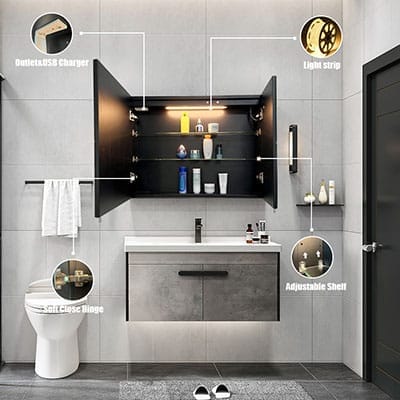
Iron steel medicine cabinets offer heavy-duty construction for industrial or vintage-inspired designs. These cabinets typically use 18-20 gauge steel (1.0-0.9mm thickness) with powder-coating for moisture resistance, welded corners for stability, and often feature visible hardware as design elements.
Finish options include matte black (most popular for industrial style), oil-rubbed bronze (traditional/vintage appeal), raw steel with clear coat (industrial aesthetic), and antiqued/distressed for character. The advantages include exceptional durability (20+ year lifespan), robust vintage or industrial aesthetic, ability to support heavy items, and resistance to impacts and damage.
Limitations include heavier weight (20-40 lbs) requiring secure mounting, potential for rust if the finish is damaged, limited style versatility, typically higher cost ($200-$600), and fewer color options than other materials. These cabinets are best suited for industrial design bathrooms, vintage/rustic style spaces, commercial or high-traffic bathrooms, and spaces where durability is paramount.
Examples include Restoration Hardware Industrial Steel Medicine Cabinet, Pottery Barn Vintage Recessed Medicine Cabinet, and custom blacksmith-crafted iron medicine cabinets.
Stainless steel
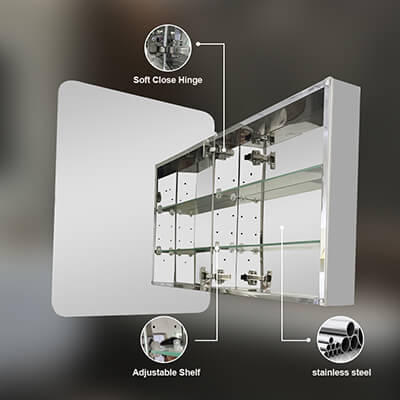
Stainless steel medicine cabinets offer premium durability and contemporary style. Grade specifications include Type 304 stainless (18/8) for most bathrooms, Type 316 (marine grade) for extreme humidity environments, 20-22 gauge (0.8-0.7mm) typical thickness, and #4 brushed finish for fingerprint resistance.
Construction features welded seams with polished finishes, reinforced corners for stability, magnetic door closures, and weights typically between 15-25 lbs depending on size. Advantages include exceptional corrosion resistance (rated for 95% RH environments), non-porous surfaces that inhibit bacterial growth, extreme durability (25+ year lifespan), minimal maintenance, and contemporary, clean aesthetics.
Design variations include mirror-polished finishes for maximum reflectivity, brushed/satin finishes for fingerprint resistance, patterned textures for visual interest, and combinations with glass or wood elements. Prices range from $150-$800 depending on size and features.
Stainless steel cabinets work best in modern and contemporary bathrooms, high-humidity environments, for health-conscious homeowners (antimicrobial properties), and as long-term quality investments. Examples include Kohler Catalan aluminum/stainless medicine cabinet, Robern M Series stainless steel medicine cabinets, and Pottery Barn Classic stainless steel recessed cabinet.
Aluminum Alloy
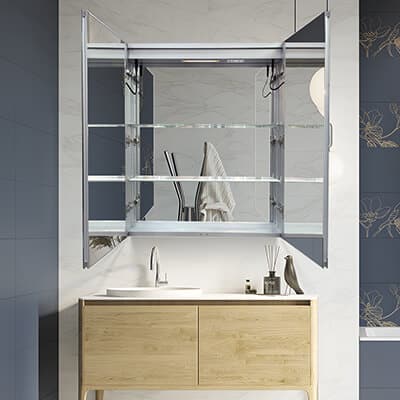
Aluminum alloy medicine cabinets offer lightweight yet durable construction popular in modern designs. These typically use 6063-T5 aluminum alloy with anodized finishes for corrosion protection. Aluminum weighs approximately 1/3 as much as steel, with average cabinets weighing 8-15 lbs.
Finish options include clear anodized (silver appearance), black anodized, bronze anodized, and powder-coated in various colors. The advantages include excellent corrosion resistance, lightweight construction for easier installation, immunity to rust, good strength-to-weight ratio, modern appearance, and lower cost than stainless steel (30-40% less).
Limitations include less rigidity than steel (potentially requiring additional bracing), greater susceptibility to denting, limited traditional style options, and typically only being available in contemporary designs. Prices range from $100-$400 depending on size and features.
Aluminum cabinets are ideal for modern and minimalist bathroom designs, where weight restrictions apply, humid environments requiring corrosion resistance, and as budget-conscious alternatives to stainless steel. Examples include Kohler Verdera aluminum construction cabinets, IKEA Godmorgon aluminum-framed cabinets, and Jensen Aluminum Frame Medicine Cabinets.
Medicine Cabinet Shapes
Rectangular
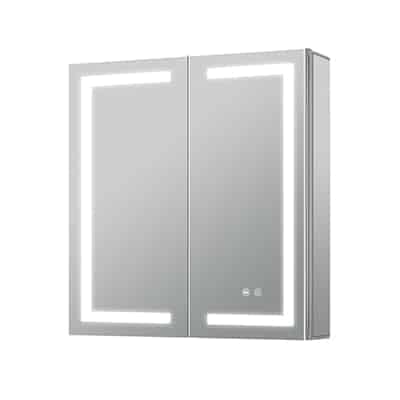
Rectangular cabinets dominate with 70% of SKU share. Dimensional standards include widths of 14″-36″ (most popular 20″-24″), heights of 18″-35″ (most popular 26″-30″), and typical proportions following 3:4 or 2:3 height-to-width ratios.
Design variations include vertical rectangles (most common for single-sink applications), horizontal rectangles (for above double vanities), and square or near-square options (less common, typically 24″×24″).
Round
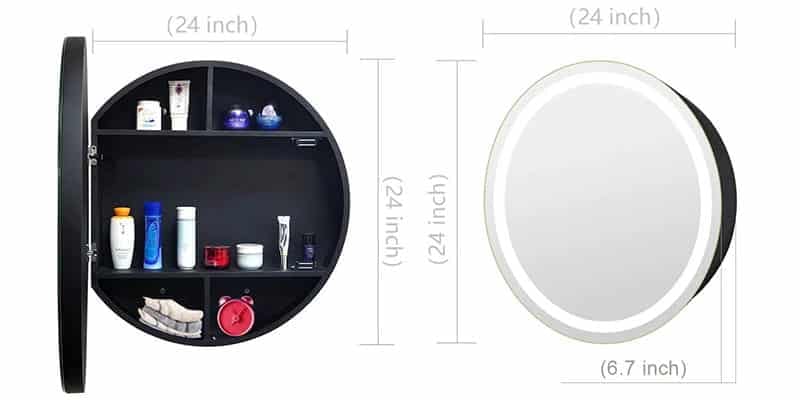
Round medicine cabinets offer distinctive circular shapes for design impact, and are trending in boutique hotels. Size specifications include diameters typically 18″-30″, depths of 3″-6″ depending on mounting style, with 24″ diameter being most popular.
Oval-Shaped

Oval-shaped medicine cabinets offer elegant alternatives to rectangular cabinets with softer lines. Common dimensions include 20″W×30″H (standard), 24″W×36″H (large), and 16″W×24″H (small), typically with 3″-5″ depth.
Arched
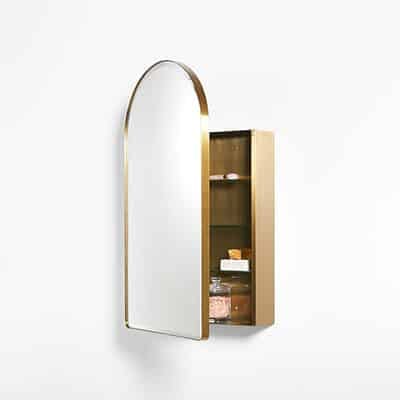
Arched medicine cabinets feature curved tops with straight sides and bottoms. Standard dimensions include widths of 18″-30″ (base), heights of 24″-36″ (total), arch rises typically 3″-6″ above rectangular portions, and depths of 3″-6″ depending on mounting type.
Medicine Cabinet Styles: Mirror Edges & Framing Options
Beveled
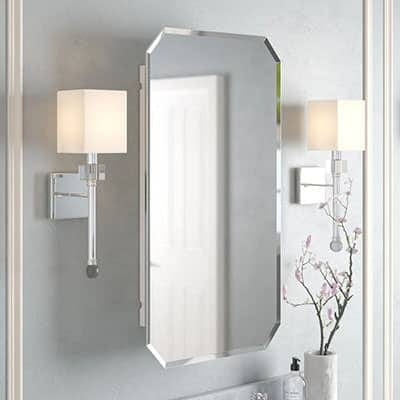
Beveled mirror edges feature angled cuts around the perimeter creating prismatic effects.
Polished
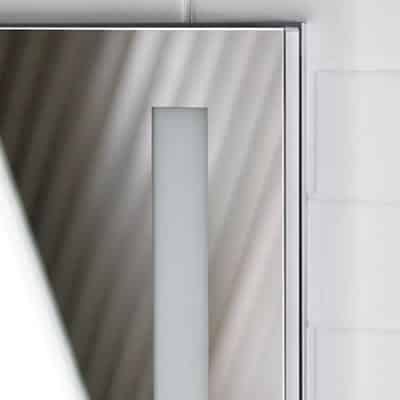
Flat CNC-polished edges that create a contemporary frameless appearance.
Also read: 15 Different Glass and Mirror Edgework Types
Framed
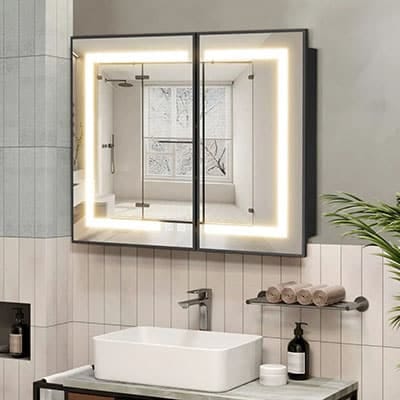
Framed medicine cabinets feature visible borders surrounding mirror doors. Frame material options include wood (traditional choice, various species), metal (aluminum, steel, bronze), composite/plastic (budget options), and mixed materials (wood with metal accents).
Frameless
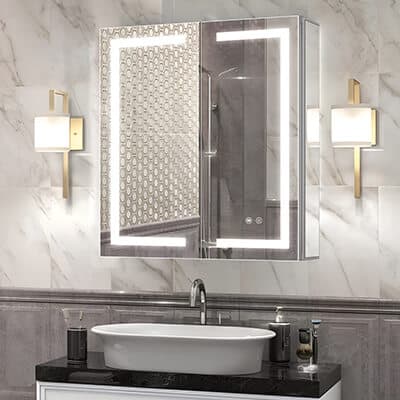
Frameless medicine cabinets offer clean designs without visible borders around mirrors. Construction details include polished or beveled mirror edges, doors attaching directly to cabinet boxes, concealed hinges for clean appearances, and mirror thicknesses typically 4-6mm for stability.
Standard Medicine Cabinet Size
Industry standard dimensions for ready-made medicine cabinets include width ranges of 14″-36″ (most common 20″, 24″, 30″), height ranges of 18″-35″ (most common 26″, 30″), and depth ranges of 3″-4″ for recessed (standard 3.5″ for 2×4 wall construction) and 4″-8″ for surface-mount (standard 5″ for adequate storage).
The most popular sizes by installation type include recessed single (20″W × 26″H × 3.5″D), recessed double (24″W × 30″H × 3.5″D), surface-mount single (20″W × 26″H × 5″D), and tri-view (36″W × 30″H × 5″D). Size restrictions based on mounting type include recessed cabinets limited by stud spacing (typically 16″ OC), corner cabinets typically 16″W × 30″H, and oval cabinets commonly 20″W × 28″H.
Interior dimensions are typically 1″-2″ less than exterior dimensions, with standard shelf depths of 3″-4″, shelf height spacing of 4″-6″ adjustable, and 2-4 shelves depending on cabinet height. Scale considerations recommend 20″-24″ widths for single vanities, 30″-36″ widths for double vanities, and 16″-20″ widths for small powder rooms.
Also read: Standard Medicine Cabinet Size
What Size Medicine Cabinet Should You Get?
When determining the appropriate medicine cabinet size, consider bathroom dimensions and available wall space, number of users sharing the cabinet, storage needs and typical product inventory, vanity width (cabinet typically matches or is slightly narrower), and wall construction for recessed installation.
Follow these guidelines for proper sizing:
- Width should not exceed vanity width; equal width is acceptable if there are no side sconces
- Maintain 3-4 inches of clearance below light fixtures and above faucets
- Depth requirements: 4 inches accommodates items up to pill-bottle size; over 5 inches needed for hairspray cans
- Height options: 30 inches is standard; 35 inches for tall users; 18-24 inches for petite vanities
- Center alignment: position the mirror midpoint at average eye level (approximately 60 inches for mixed-gender households)
Features to Consider
Mirrored Interior
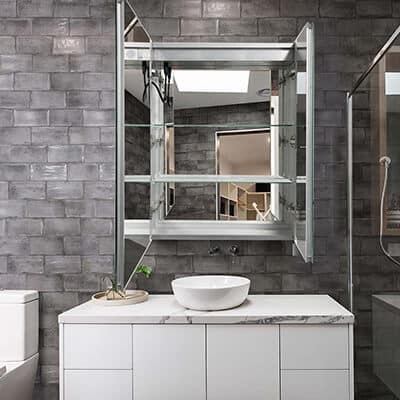
Medicine cabinets can have mirrors on the inside, which can help reflect light and improve visibility. This feature can also create a more spacious appearance inside the cabinet. Additionally, when the main door is open, you can use the mirror to see the back of your head.
Medical Lock
Medical locks provide security features restricting access to medications. Lock types include basic key locks (most common), combination locks with 3-4 digit codes, electronic keypad locks on premium models, and biometric fingerprint scanners on high-end smart cabinets.
Push-Button Doors
eliminate the need for handles using spring-loaded push-latch mechanisms, magnetic push-release systems, or electronic touch-release on premium models. These doors open 1-2 inches when pressed for easy grasp and close with gentle pressure until the latch engages, with typical lifecycles of 25,000-50,000 operations.
Mirror Defoggers
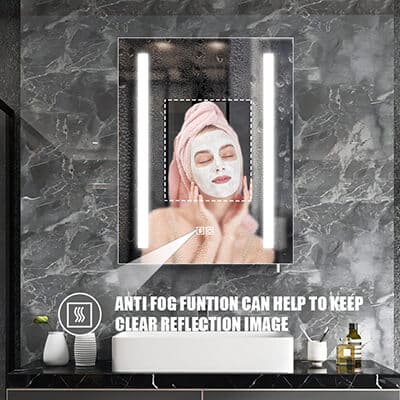
Mirror defoggers are heating elements that prevent mirror fogging during showers. The technology involves thin heating pads applied to mirror backs, operating at 100-120°F (38-49°C), consuming 15-25 watts, and preventing condensation by maintaining mirrors above dew points.
Electrical Outlet (Jack & USB Plug Socket)
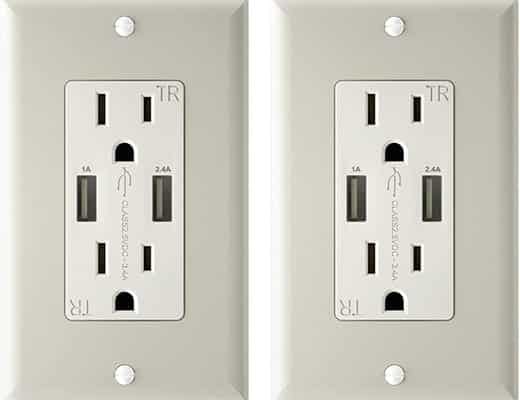
Integrated power options within medicine cabinets include standard 120V outlets (GFCI protected), USB-A charging ports (5V, 2.1A), USB-C ports (newer models, 5V, 3A), and combination outlets with multiple functions. Location options can be interior back wall mounting, side panel installation, interior shelves with cutouts for cords, and exterior lower edges of cabinets.
Adjustable Shelves
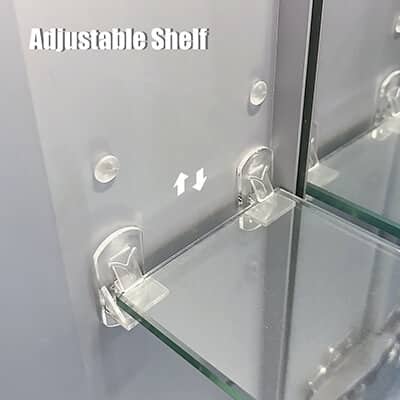
Adjustable interior shelving allows customizable storage using metal shelf pins in pre-drilled holes (most common), metal track systems with clips, notched side supports, or tool-free adjustment systems on premium models.
Adjustable Hinges
Adjustable hinges allow precise door positioning and alignment with 3-way adjustment capabilities (horizontal, vertical, depth). Typical adjustment ranges include ±2mm horizontal, ±2mm vertical, and ±1mm depth.
Technical specifications include European-style cup hinges (most common), 110° standard opening angles, optional 170° wide-angle hinges, soft-close mechanisms on premium models, and load capacities up to 5 lbs per hinge.
Concealed Hinges
Concealed hinges provide hidden door mounting hardware for clean aesthetics. Design characteristics include complete invisibility when doors are closed, inside cabinet mounting, cup-style or European designs (most common), and various finishes matching interiors.
Interior Lights

Interior cabinet illumination improves visibility using technologies like LED strip lights (2700K-6000K adjustable color temperature), puck lights for directional illumination, linear fixtures along cabinet tops, or light panels on side walls.
Power sources include hardwiring to home electrical (most common), battery operation with motion sensors, USB rechargeable systems on newer models, and connections to existing bathroom lighting circuits.
Side Kit
The side kit typically comes with dual-mountable medicine cabinets. To convert a recessed cabinet to a surface mount type, you need to add a set of panels to both exterior sides for a smooth appearance.
Front Door Lights
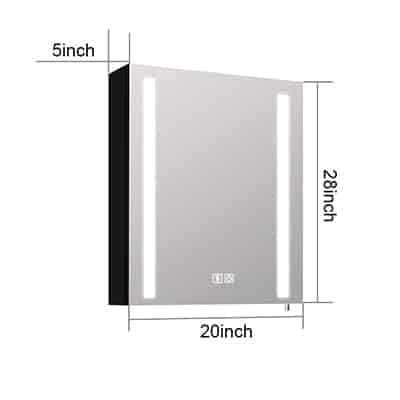
Medicine cabinets with front door mirrors serve as functional bathroom mirrors for daily grooming. Integrating LED lights on the door fronts can enhance the makeup application experience. These LEDs provide high-quality lighting with a Color Rendering Index (CRI) of 90, which mimics natural sunlight to reflect true colors in the mirror. Additionally, the lights are dimmable, allowing you to adjust the brightness to your preference.
Bluetooth Connection
Bluetooth integration incorporates wireless audio technology into medicine cabinets, compatible with Bluetooth 5.0 or newer protocols. It offers a range of approximately 30 feet, can pair with up to 8 devices, and features water-resistant speakers with an IPX4 or better rating.
Magnifying Mirrors for Makeup
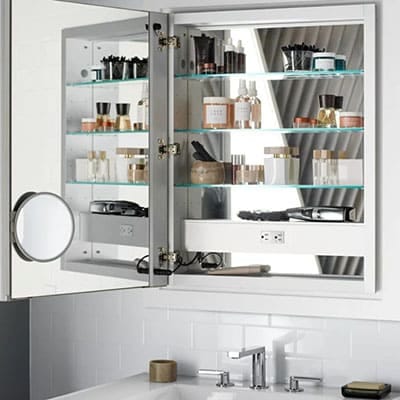
Specialized mirror sections with enhanced magnification offer various levels including 3× (most common, shows detail without distortion), 5× (for detailed makeup application), 7× (for precise tasks like tweezing), and 10× (for extremely detailed work, less common).
Night Light Below the Cabinets
Low-intensity lighting at the bases of cabinets offers assistance for nighttime navigation. This subtle glow typically ranges from 5 to 20 lumens—much lower than the 800+ lumens produced by standard lighting—making it safe for movement. The lights have warm color temperatures between 2700K and 3000K to minimize disruption to sleep, and their diffused output helps to avoid harsh shadows or glare.
Voice-Control
Voice command recognition allows for hands-free operation to control lights and AI assistants.
Considerations Guide You to Choose the Right Medicine Cabinet
When selecting a medicine cabinet, prioritize factors including available space and installation limitations, storage requirements and household size, design aesthetic and bathroom style, budget constraints, and special features needed.
- Budget: Options range from $60 for basic plastic swing-door models to $3,500 for smart aluminum voice-controlled units like the Robern Uplift.
- Bathroom Size & Layout: Ensure adequate door swing clearance and avoid collisions with lighting fixtures or tall faucets.
- User Profile: Households with children should prioritize lockable units; seniors may benefit from larger pulls and soft-close hinges.
- Aesthetic Cohesion: Match frame finishes to vanity hardware and select beveled edges for traditional décor schemes.
- Storage Needs: Quantify specific items for storage—for example, an 8″ × 6″ × 4″ electric toothbrush charger requires a shelf depth of at least 6 inches.
- Future Upgrades: Consider dual-mount designs for renovation flexibility; modular cabinets can be ganged together for double vanity setups.
- Regulatory & Safety: Adhere to National Electrical Code requirements for in-cabinet outlets; verify local code compliance for GFCI protection and ADA reach-range (maximum 48-inch shelf height).
- Sustainability: Look for FSC-certified wood, low-VOC finishes, and recyclable aluminum components.
The medicine cabinet market continues to evolve with smart home integration and enhanced functionality. When selecting the right unit for your bathroom, balancing practical storage needs with aesthetic preferences and technological features will ensure long-term satisfaction with your investment.
